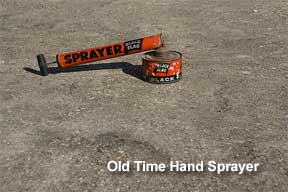There is a type and size of sprayer designed to fit everyone’s needs (and pocketbooks)… all the way from the person with only a few house plants to the large estate with acres of gardens or orchards.
Most gardeners prefer to have a separate sprayer, properly marked or labeled, just for chemically controlling weeds. Many of the weed killers are extremely difficult to get completely cleaned out of sprayers. Check with your local county extension service on how to decontaminate sprayers in which chemicals (especially weed killers) have been used; or contact the chemical manufacturer. This is important.

Should you dust or spray? There really isn’t an answer to this question. Effective disease and insect control depends on applying the right chemical, at the right time and in the right way.Strive for even, thorough coverage whether dusting or spraying. Many gardeners prefer to dust vegetables throughout the season, but dust flowers only in the spring. Since today’s sprays do not leave an objectionable deposit, spraying is considered better for flowers in or near bloom.
Accessories for Hand Operated Sprayers
A wide variety of accessories and fittings are manufactured to meet various special needs. These are adaptable to compressed-air, knapsack and hand operated spray pumps.
Special angle and swivel nozzles for underleaf spraying, and adjustable nozzles which permit spraying from a fine mist to a solid stream, are useful. Fan pattern nozzles are available for weed spraying. A range of nozzle disc inserts and. extension rods in several lengths (which can be screwed together to spray fruit trees) are offered by most manufacturers. Special spray booms with two or three nozzles; extra lengths of spray hose, which increases maneuverability; two-wheeled rubber-tired carts for transporting large sprayers; a pressure tank to avoid continuous pumping; narrow tank models for special jobs; these are only a few. New ones come out every year.
